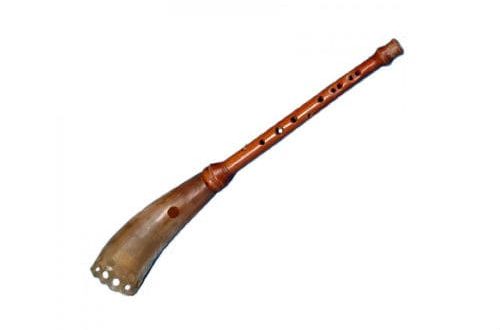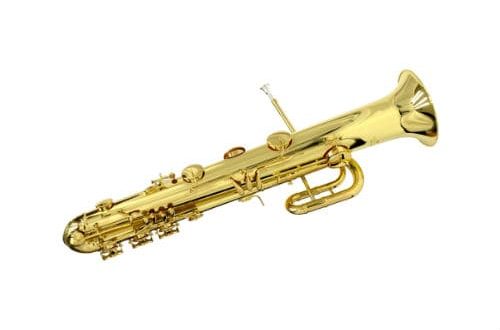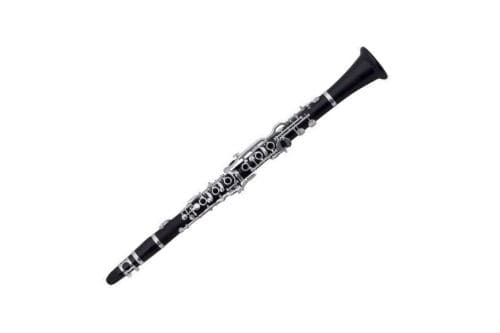
Clarinet: description of the instrument, composition, sound, types, history, use
Contents
A neighbor from the famous song by Edita Piekha, playing the clarinet and trumpet, most likely was a real multi-instrumentalist. Two musical instruments, although they belong to the wind group, are completely different. The first is a wooden reed with valves, the second is a copper mouthpiece with valves. But most music school students learning to play brass start with a younger “relative”.
What is a clarinet
The elegant representative of the brass family occupies a special place in the symphony orchestra. An extensive range of sound and a soft, noble timbre allows musicians to use it to create a variety of music. Especially for the clarinet, Mozart, Gershwin, Handel wrote music. Composer Sergei Prokofiev assigned him the independent role of a cat in the symphonic fairy tale Peter and the Wolf. And N. Rimsky-Korsakov used Lel in the opera The Snow Maiden in the shepherd’s tunes.
The clarinet is a reed wooden instrument with a single reed. Belongs to the group of wind. The main distinguishing feature from other members of the family is its wide expressive possibilities, which allow it to be used solo, as part of symphony orchestras, to perform various genre music: jazz, folk, ethno, classics.

Clarinet device
It looks like a tube made of wood. The body length is about 70 centimeters. It is collapsible, consists of six parts:
- mouthpiece;
- cane;
- upper knee;
- lower knee;
- barrel;
- trumpet.
Sound is produced by blowing air through a key-curved mouthpiece. A reed cane is inserted into it. The pitch of the sound is determined by the size of the air column inside the device. It is regulated by a complex mechanism equipped with a valve system.
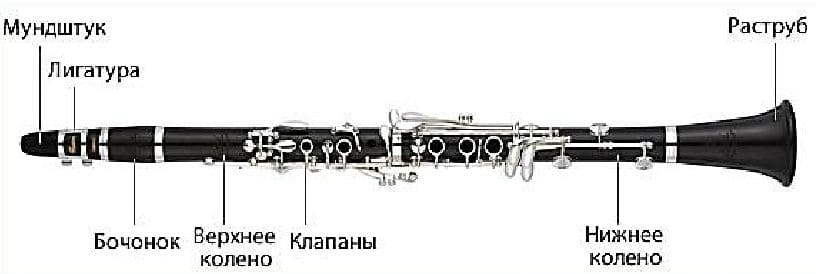
The clarinet is a transposing instrument. The most common examples are in the “Si” and “La” tunings. They are also called “sopranos”. Other varieties exist and enjoy the right to sound in the orchestra, among which are high-sounding and low-sounding. Together they make up a whole family.
The clarinet is high-pitched
Beginning clarinetists begin their training with them. The very first in the hands of young musicians is an instrument in the “Do” system. It sounds exactly according to the notes, so it makes it easier to master the basics. Sopranino and piccolo are rarely trusted to solo in orchestras. In the upper register they sound defiant, sharp with a pronounced squeal. Instances in “in C” tuning are almost never used by professionals.
The clarinet tunes low
They differ from those listed above not only in pitch, but also in structure and size. For their manufacture, metal parts are used. Unlike altos, their bell and tube are made of metal. It has a curved shape, like a saxophone, bends for ease of playing. In an orchestra, the bass, contrabass, and basset horn are the lowest-sounding types.

What does a clarinet sound like?
Soft timbre sound is not the only advantage of the instrument. Its main feature is the availability of a flexible change in the dynamic line. It varies from an intense, expressive sound to a faint, almost fading sound.
The range is extensive, it is almost four octaves. In the lower case, the reproduction is gloomy. Changing the sound upward reveals light, warm tones. The upper register makes it possible to reproduce sharp, noisy sounds.
The area of expressiveness is so large that the great composer V.A. Mozart confidently compared the instrument to the human voice. Drama, measured narration, playful, flirtatious sound – everything is subject to this representative of the wind family.
History of the clarinet
In the XNUMXth century, musicians played the chalumeau. This is the national folk instrument of the French. It is believed that a Bavarian by origin I.K. could come up with a clarinet. Denner. He considered the sound of the chalumeau to be imperfect, and worked to improve its design. As a result, the wooden tube has a valve on the back. By pressing it with the thumb of the right hand, the performer translated the sound into the second octave.
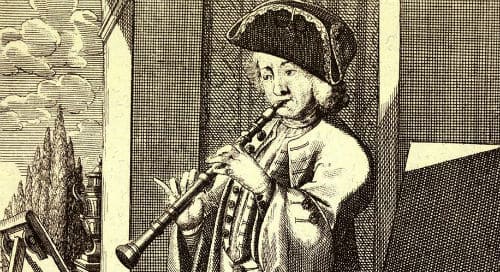
The timbre features were similar to those of the clarine, common at that time. This trumpet had a clear sound. The origin of the name has southern European roots. The new instrument was called clarinetto – a small pipe translated from Italian. Chalumeau and Clarinet were both popular in France. But the wider possibilities of the latter became a prerequisite for the elimination of the predecessor.
Son I.K. Denner Jacob continued the work of his father. He invented the two-valve clarinet. Other prominent masters of the second half of the XNUMXth century succeeded in improving Jacob’s models by adding a third, fourth and fifth valve. The Zh-K model has become a classic. Lefevre with six valves.
This design improvement did not end there. In the XNUMXth century, two schools of playing the clarinette emerged. The first half of the nineteenth century was marked by the heyday of an instrument called the German clarinet. It was equipped with annular valves, which the flutist of the Munich court choir Theobald Böhm decided to use. This model was improved by the Berlin clarinetist Oskar Ehler. The German system clarinet was used in Europe for a long time, until another system appeared – the French system. The difference between one and the other lies in the degree of expressiveness of the sound, the technology of production of mouthpieces, and other details. The French clarinet was more suitable for virtuoso playing, but had little expressiveness and sound power. The difference was in the valve system.
Modern manufacturers continue to improve parts of the clarinet using different materials, expanding the performance with many springs, rods, screws. In Russia, Germany, Austria, the traditional model based on German standards is traditionally used.
Varieties of clarinets
The classification of the instrument is very extensive. It is determined by the tone and timbre. The small clarinet (piccolo) is almost never used. The ensemble most often uses “basset” with a specific “plaintive” timbre. Other varieties are used in orchestras:
- bass – rarely used solo, more often used to enhance bass voices;
- contralto – included in the brass bands;
- double bass – allows you to extract the lowest notes, the largest of all types.
In the military brass bands of the United States, alto instruments are widely used. They have a powerful sound, full-sounding, expressive.
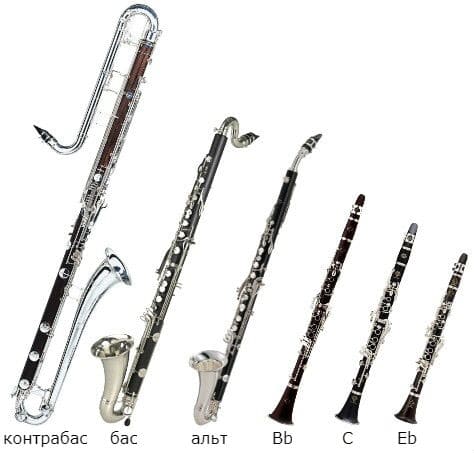
Clarinet technique
As new types appeared, the instrument was improved, the technique of owning it also changed. Thanks to the technical mobility of this representative of the wind family, the performer can play chromatic scales, expressive melodies, reproduce overtones, passages.
The range of boundaries from “Mi” of the small octave to “Do” of the fourth allows the instrument to take part in most works. The musician plays by blowing air into a hole in the mouthpiece with a reed. The length of the column, tonality, timbre are regulated by valves.
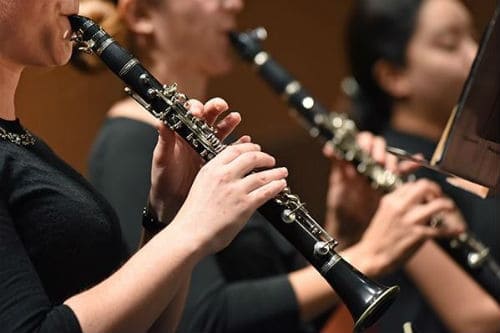
Outstanding clarinetists
In musical history, virtuosos are noted who perfectly mastered the technique of playing the clarinetto. The most famous:
- G.J. Berman is a German musician who revised many of Weber’s early works and adapted them to the sound of the instrument;
- A. Stadler – he is called the first performer of Mozart’s works;
- V. Sokolov – in the Soviet years, this performer was received by full halls of fans of classical sound in different cities of the country and abroad.
B. Goodman achieved great heights in jazz. He is called the “King of Swing”. An interesting fact is connected with the name of the jazzman – at one of the European auctions, his instrument was sold for 25 thousand dollars. The Russian performing school is based on the experience and work of S. Rozanov. Modern textbooks are composed of his sketches. As a professor at the Moscow Conservatory, he took part in the creation of educational programs, according to which musicians are taught today.



